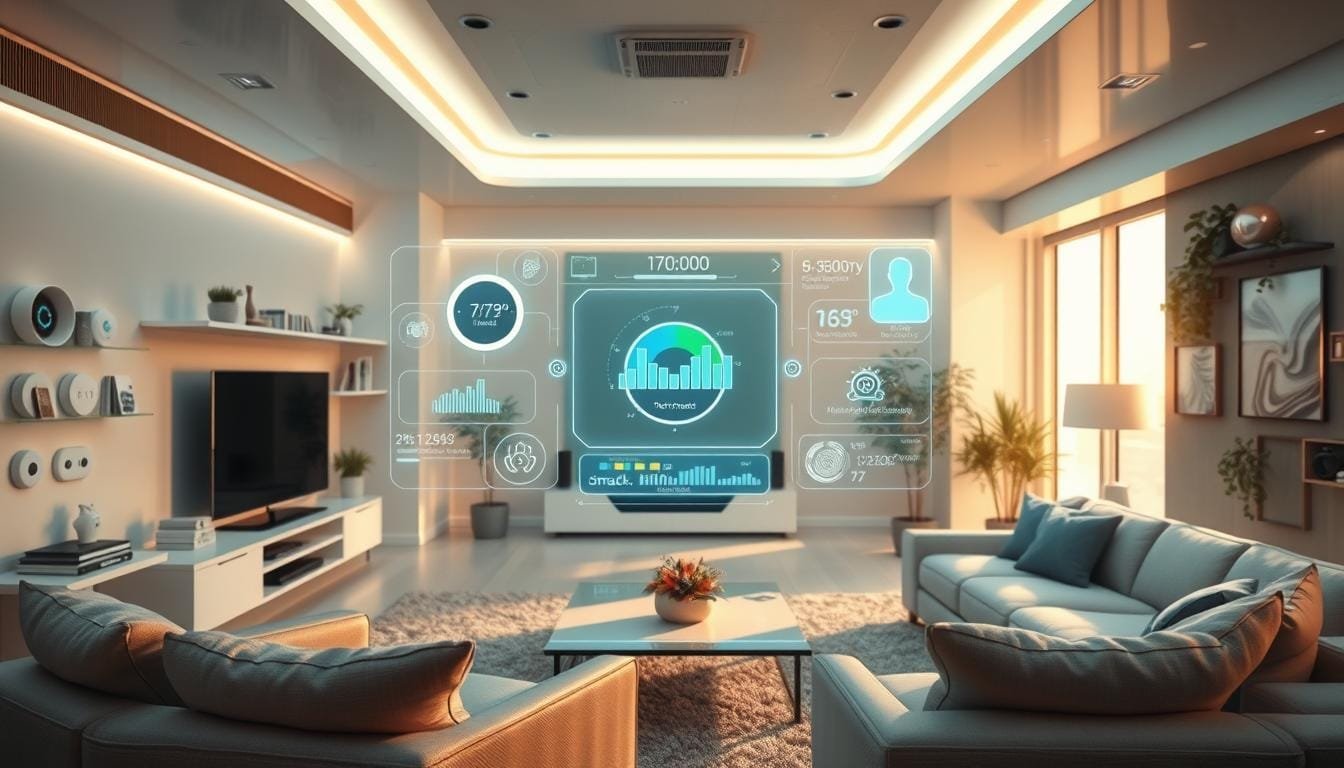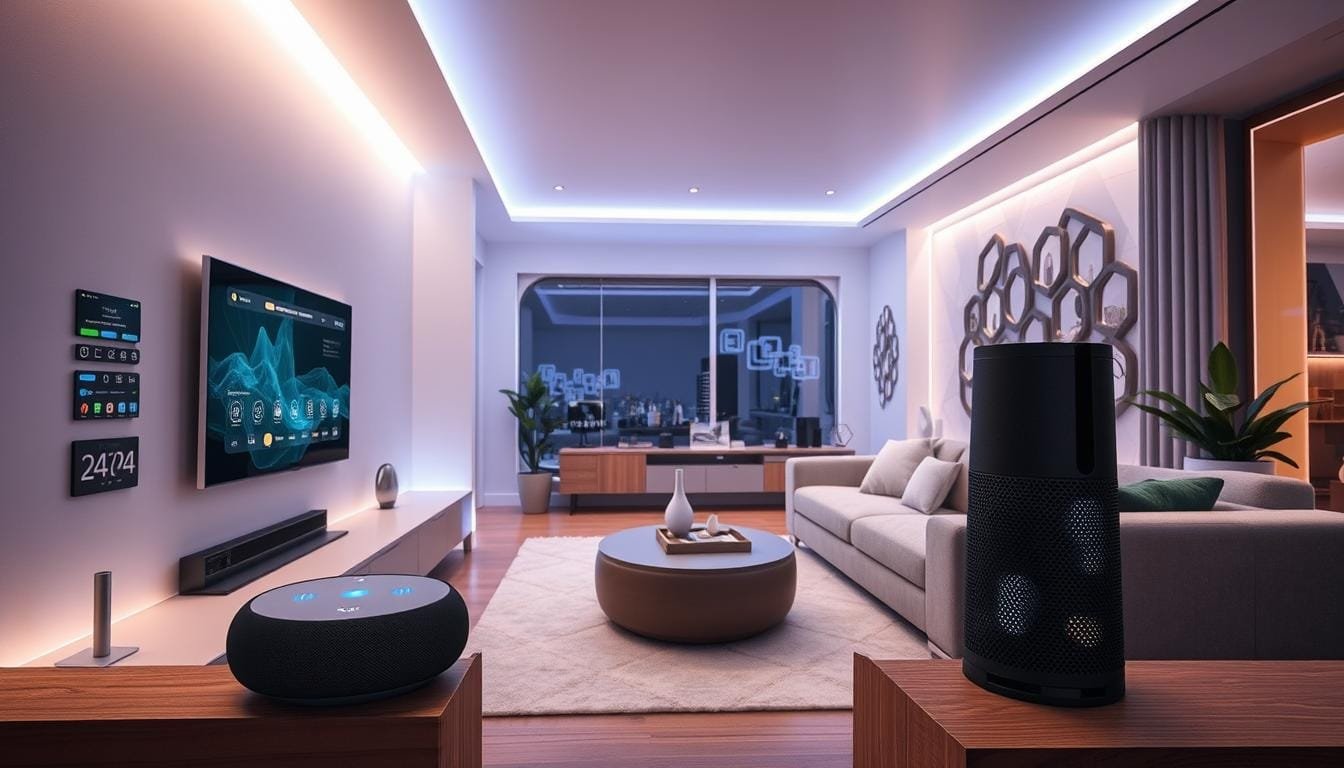Home Assistant and Homey are two top choices for smart home systems. They make controlling and watching your smart devices easy. It’s key to pick the right one for your home.
These platforms help connect many smart devices for easy home control. Choosing the right one makes your home more comfy, safe, and saves energy. We’ll look at what makes Home Assistant and Homey different.
Introduction to Smart Home Automation
Smart home tech is getting more popular fast. Companies like Home Assistant and Homey are leading the way. They offer cool features to make your home smarter and easier to manage.
Key Takeaways
- Home Assistant and Homey are two popular smart home platforms
- Smart home platforms integrate various smart devices for seamless home automation
- Choosing the right platform is essential for a comfortable and secure living space
- Home Assistant and Homey offer a range of features and capabilities
- Smart home automation is a rapidly growing field with many innovative solutions
- Home automation can make homes more energy-efficient and convenient
Understanding Smart Home Automation Platforms
Smart home devices and home automation systems have changed how we live. They let us control and watch our homes easily. This makes our lives better and more efficient.
The world of home automation has grown a lot. New tech and devices have come out. Now, we have many devices that work with different platforms. It’s important to think about which platform works best with your devices.
Key Characteristics of Smart Home Platforms
- Compatibility with various smart home devices
- Scalability to accommodate future additions
- User-friendly interface for easy control and monitoring
- Customization options to suit individual needs
When picking a smart home platform, think about these points. They help make sure your experience is smooth and useful. Knowing about home automation and smart platforms helps us choose the right one for us.
Home automation has grown a lot. We can expect even more cool things in the future. It’s important to keep up with new tech and trends in home automation.
Home Assistant: An In-Depth Look
Home Assistant is a popular open-source platform for smart home integration. It lets users connect many smart devices and make their own automation plans. It’s very flexible and customizable, making it a top choice for smart home fans.
Home Assistant can work with lots of devices, like lights, thermostats, security cameras, and door locks. This means users can control and automate their smart home devices from one place. It’s easy to manage their home’s systems. Users can also make their own automation plans, like turning on lights when they enter a room or locking doors when they leave.
Some benefits of using Home Assistant include:
- Customization options: Home Assistant lets users tailor their smart home setup to their needs and likes.
- Integration with multiple devices: Home Assistant works with many devices, making it simple to control and automate different systems.
- Open-source: Home Assistant is open-source, so users can change and add to its features as they want.
Overall, Home Assistant is a strong and adaptable platform for smart home integration. It has lots of features and customization options. It’s great for both seasoned smart home users and those just starting out.
Homey: Platform Overview and Capabilities
Homey is a smart home hub that makes controlling devices easy. It’s designed for everyone to use. Homey connects many devices and systems together smoothly.
Homey can learn and act like you. It works with many devices and systems. You can use voice commands, apps, or web to control your devices.
Core Features
- Device automation and control
- Scene management and customization
- Voice command support
- Mobile app and web interface control
System Requirements
To use Homey, you need a device that meets certain needs. It should have the right operating system and enough power. Homey works with many devices, so finding one is easy.
Integration Options
Homey has many ways to connect devices and systems. It supports popular smart home devices and protocols. This makes it simple to add Homey to your smart home.
| Device/Protocol | Integration Status |
|---|---|
| Philips Hue | Supported |
| Amazon Alexa | Supported |
| Google Home | Supported |
Setup and Installation Process
Setting up a smart home is a big step. It’s important to do it right. We’ll show you how to set up Home Assistant and Homey. This will help you start your smart home journey.
Before you start, think about what you need. Decide which devices you want and how you’ll control them. Home Assistant and Homey let you customize your setup.
Getting Started with Home Assistant
To start with Home Assistant, install the software on your device. Follow the steps on the Home Assistant website. Then, you can set up your devices and start automating your home.
Setting Up Homey
Homey has a simple setup guide. It helps you install and connect your devices easily. You can customize your setup right from the start.
Follow these steps to make your smart home work well. Plan ahead and set up your devices carefully. Use the options in Home Assistant and Homey to make your home smart.
Device Compatibility and Integration Options
When picking smart home devices, it’s key to think about how well they work together. Home Assistant and Homey both let you connect many devices easily. Device integration is very important for a smart home.
Many popular devices, like thermostats and security cameras, work with both Home Assistant and Homey. They also support Zigbee and Z-Wave, making it simple to manage lots of devices. It’s important to pick a platform that fits your devices and protocols.
Here are some important things to think about for device compatibility and integration:
- Check the platform’s compatibility list to ensure your devices are supported
- Consider the integration protocols used by your devices, such as Zigbee or Z-Wave
- Look for platforms that offer seamless device integration and control
By thinking about these points and picking the right platform, you can make your smart home work smoothly. This will make your smart home devices work better together.
User Interface and Experience Comparison
Smart home automation’s user interface and experience are key. A good interface makes controlling devices easy. We’ll look at Home Assistant and Homey, two top platforms.
Both platforms have user-friendly interfaces. Home Assistant lets you customize your dashboard. Homey has a sleek design that’s simple to use. Both make controlling devices easy.
Dashboard Customization
Customizing your dashboard is important. Home Assistant lets you add widgets and cards. Homey’s dashboard is simple and easy to use.
Mobile App Experience
The mobile app is crucial for smart homes. Home Assistant and Homey have apps for on-the-go control. They offer features like push notifications and remote access.

Automation Creation
Creating automations is a big feature. Home Assistant and Homey have tools for custom automations. They’re easy to use, focusing on simplicity.
In summary, Home Assistant and Homey offer great user experiences. Their interfaces are customizable, and their apps are handy for remote control. Choosing the right platform means a personalized and easy experience.
Pricing Structure and Value Analysis
Smart home automation costs are important to think about. Home Assistant and Homey have different prices. It’s key to know the costs of each to make a good choice.
Home Assistant costs less upfront, with a one-time fee for the hardware. But, you might need to buy more devices to use it fully. Homey has a subscription model with different plans. Each plan offers different features and benefits.
Comparing Pricing Models
Home Assistant is cheaper for those who like to customize. But, Homey’s subscription gives you updates, support, and more devices.
Here’s a look at the costs for each platform:
| Platform | Upfront Costs | Monthly/Annual Fees |
|---|---|---|
| Home Assistant | $100-$300 | None |
| Homey | $200-$500 | $10-$30/month |
In conclusion, Home Assistant and Homey have different prices. Think about your budget and needs before choosing a smart home platform.
Performance and Reliability Metrics
When we look at smart home platforms like Home Assistant and Homey, we see many important factors. Smart home performance is key for a smooth and efficient experience. We need to think about system needs, device matching, and the platform’s design.
Reliability metrics like uptime and error rates are very important. A good platform should be up most of the time and have few errors. To keep it this way, we must watch how it works and fix problems fast.
Here are some tips to boost smart home performance and reliability metrics:
- Regular software updates
- Optimizing device configuration
- Monitoring system logs
By working on these points, users can make sure their smart home runs well. This makes for a better experience overall.

The main aim is to have a smart home that’s both strong and dependable. We want users to have a seamless and fun experience.
| Platform | Uptime Percentage | Error Rate |
|---|---|---|
| Home Assistant | 99.9% | 0.1% |
| Homey | 99.5% | 0.2% |
Conclusion: Choosing Between Home Assistant and Homey
Both Home Assistant and Homey are great for smart homes. But, your choice depends on what you need and your devices. Think about your home automation plans.
Home Assistant is perfect for those who love to customize. It works with many devices and has a big community. It’s great for making your smart home just right for you.
Homey is easy to use and set up. It’s perfect for beginners. Its app is simple, and it works with many devices. This makes automating your home easy.
Choosing between Home Assistant and Homey depends on what you want. Think about your devices, how easy you want it to be, and how much you want to customize. This will help you pick the best for your smart home.
